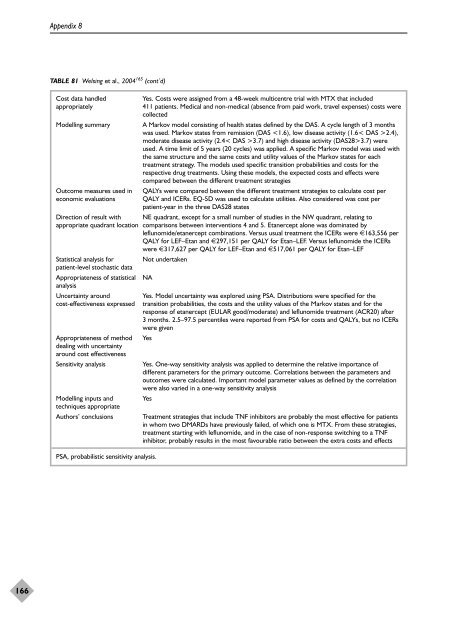A systematic review of the effectiveness of adalimumab
A systematic review of the effectiveness of adalimumab
A systematic review of the effectiveness of adalimumab
Create successful ePaper yourself
Turn your PDF publications into a flip-book with our unique Google optimized e-Paper software.
166<br />
Appendix 8<br />
TABLE 81 Welsing et al., 2004 165 (cont’d)<br />
Cost data handled Yes. Costs were assigned from a 48-week multicentre trial with MTX that included<br />
appropriately 411 patients. Medical and non-medical (absence from paid work, travel expenses) costs were<br />
collected<br />
Modelling summary A Markov model consisting <strong>of</strong> health states defined by <strong>the</strong> DAS. A cycle length <strong>of</strong> 3 months<br />
was used. Markov states from remission (DAS 2.4),<br />
moderate disease activity (2.4< DAS >3.7) and high disease activity (DAS28>3.7) were<br />
used. A time limit <strong>of</strong> 5 years (20 cycles) was applied. A specific Markov model was used with<br />
<strong>the</strong> same structure and <strong>the</strong> same costs and utility values <strong>of</strong> <strong>the</strong> Markov states for each<br />
treatment strategy. The models used specific transition probabilities and costs for <strong>the</strong><br />
respective drug treatments. Using <strong>the</strong>se models, <strong>the</strong> expected costs and effects were<br />
compared between <strong>the</strong> different treatment strategies<br />
Outcome measures used in QALYs were compared between <strong>the</strong> different treatment strategies to calculate cost per<br />
economic evaluations QALY and ICERs. EQ-5D was used to calculate utilities. Also considered was cost per<br />
patient-year in <strong>the</strong> three DAS28 states<br />
Direction <strong>of</strong> result with NE quadrant, except for a small number <strong>of</strong> studies in <strong>the</strong> NW quadrant, relating to<br />
appropriate quadrant location comparisons between interventions 4 and 5. Etanercept alone was dominated by<br />
leflunomide/etanercept combinations. Versus usual treatment <strong>the</strong> ICERs were €163,556 per<br />
QALY for LEF–Etan and €297,151 per QALY for Etan–LEF. Versus leflunomide <strong>the</strong> ICERs<br />
were €317,627 per QALY for LEF–Etan and €517,061 per QALY for Etan–LEF<br />
Statistical analysis for Not undertaken<br />
patient-level stochastic data<br />
Appropriateness <strong>of</strong> statistical NA<br />
analysis<br />
Uncertainty around Yes. Model uncertainty was explored using PSA. Distributions were specified for <strong>the</strong><br />
cost-<strong>effectiveness</strong> expressed transition probabilities, <strong>the</strong> costs and <strong>the</strong> utility values <strong>of</strong> <strong>the</strong> Markov states and for <strong>the</strong><br />
response <strong>of</strong> etanercept (EULAR good/moderate) and leflunomide treatment (ACR20) after<br />
3 months. 2.5–97.5 percentiles were reported from PSA for costs and QALYs, but no ICERs<br />
were given<br />
Appropriateness <strong>of</strong> method Yes<br />
dealing with uncertainty<br />
around cost <strong>effectiveness</strong><br />
Sensitivity analysis Yes. One-way sensitivity analysis was applied to determine <strong>the</strong> relative importance <strong>of</strong><br />
different parameters for <strong>the</strong> primary outcome. Correlations between <strong>the</strong> parameters and<br />
outcomes were calculated. Important model parameter values as defined by <strong>the</strong> correlation<br />
were also varied in a one-way sensitivity analysis<br />
Modelling inputs and Yes<br />
techniques appropriate<br />
Authors’ conclusions Treatment strategies that include TNF inhibitors are probably <strong>the</strong> most effective for patients<br />
in whom two DMARDs have previously failed, <strong>of</strong> which one is MTX. From <strong>the</strong>se strategies,<br />
treatment starting with leflunomide, and in <strong>the</strong> case <strong>of</strong> non-response switching to a TNF<br />
inhibitor, probably results in <strong>the</strong> most favourable ratio between <strong>the</strong> extra costs and effects<br />
PSA, probabilistic sensitivity analysis.
















